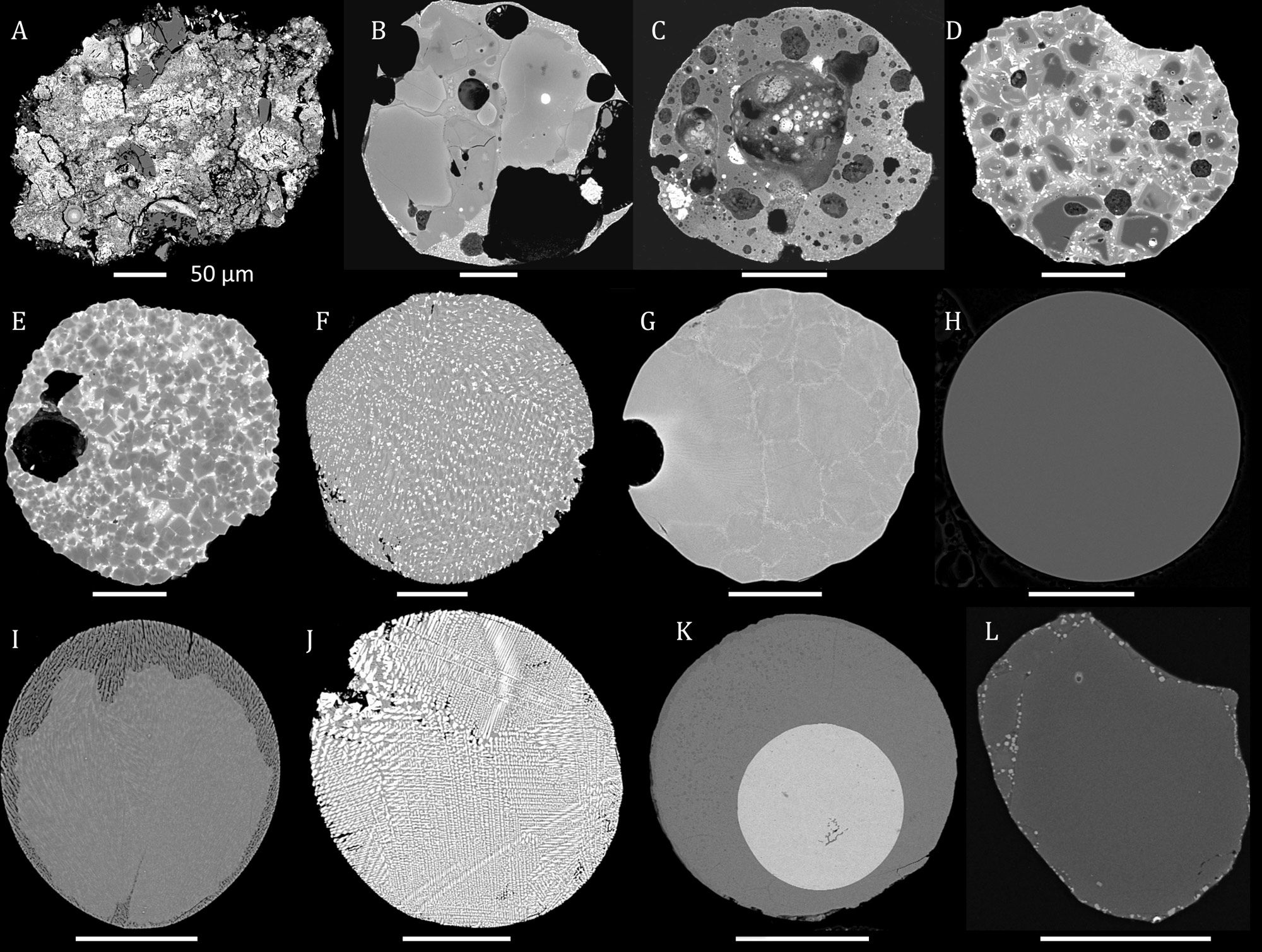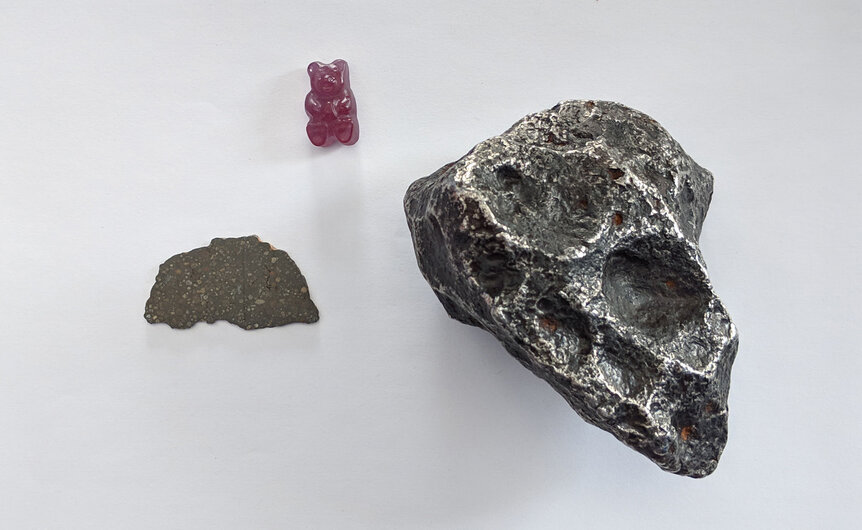Create a free profile to get unlimited access to exclusive videos, sweepstakes, and more!
Can you really find micrometeorites in your gutter? Well…

I collect meteorites, and have quite a few knocking around my home office. Some are big — fist-sized, with one I bring with me when I give talks about impacts so people can hold a piece of an asteroid in their hand — but most are pretty small, like the size of a finger from the last joint to the tip. A few are pebbles (generally well-known ones with special scientific interest, making bigger pieces hard to obtain), and a couple of are sand-grain-sized (one is from the Moon and the other from Mars).
While I don't collect them, there is another kind that’s even smaller: Micrometeorites, usually smaller than a millimeter across, some so teeny you need a microscope to see them clearly. Bigger ones (say, a tenth of a millimeter and up) are usually spherical or close to it, because they melt completely as the ram through our atmosphere at hypersonic speeds, then solidify after they've slowed down to subsonic speeds (in fact they probably fall the rest of the way extremely slowly due to their size).
Where do they come from? Well, space, duh, but they are probably already very small before they hit our atmosphere. Some are grains of material sloughed off by comets; the solid part of a comet (its nucleus) is a mixture of various ices with rocks of different sizes, right down to microscopic dust. When the comet gets near the Sun the ice turns to gas, freeing the rocks and dust, and if the Earth happens to plow through that debris stream we get meteors that include micrometeoroids*.
Others start off life as asteroids. They get covered with pebbles and dust over time from small impacts, and a bigger impact can shake that material off which can then fall to Earth. Or it’s possible these micrometeorites were also just always small, formed in the solar system as the planets were born over 4.5 billion years ago.
This material is constantly raining down on Earth, to the tune of many tons per day. Now this brings me to an interesting bit of "common knowledge": Because so many of these fall all the time, you can find them in roof gutters! The idea is that the material either just settles down to Earth and some of which lands on roofs, or it gets picked up by raindrops to the same effect. If you clean your gutters, all you have to do is dump the gunk into a baggie, hold a strong magnet next to it, and the small bit of iron common in meteorites (even stony ones) will cause them to be pulled over. Boom. Micrometeorites for your study! You can find a lot of websites talking about how to this, usually as lab exercise for kids in their science classes.
There’s a problem though. It’s been shown (in 1953!) that a lot of the samples collected this way are what’s called “fly ash”, furnace slag, small bits of ash blown into the air by furnaces, which also can have iron in them and are often spherical. In fact, “micrometeorites” found in samples seem to increase closer to urban areas, indicating that a lot of this stuff is not from space, but from industry.
So who’s right? I’ve seen people claim you can find micrometeorites this way and others say it’s all hogwash (or flyashwash, I suppose). It turns out they’re both right. Kinda.
Basically, fly ash does massively dominate the material found in gutters… but it doesn’t account for all of it. A very small portion does in fact come from space. The real problem is separating the two. You can’t do it by running a magnet over gutter goop and then visually inspecting them, which is how most of those websites talk about it. You’ll just wind up with nearly all slag.
Instead, that’s just the first step. After that you need to do some more complicated elemental analysis to look for tracers of interplanetary origin.
And this has been done! As part of a study called Project Stardust, 300 kilograms of gutter sediment was pulled from buildings in Oslo, Norway and examined (you can read more about this project and Jon Larsen, the driving force behind it, in this entertaining New York Times article) . They found about 500 spherules that were likely to be micrometeorites. These were all about 0.3–0.4 mm in size, so big enough to see. They washed the sediment, used a magnet to extract particles, then visually inspected them to cull ones that looked cosmic in origin. The paper doesn’t say how long it took, but I imagine this was not exactly an afternoon project.
Now right away, note the ratio. 300 kilos is a whole lot of glop, and finding 500 particles in it is not exactly a bonanza. That right away tells you that the idea that you can find these in your own roof goo is extremely unlikely; imagine sifting through a liter of this stuff to find just one or two grains smaller than a millimeter! And mind you, you’ll be finding thousands of similarly sized bits doing their best to fool you.
That’s too bad, really. I love the idea of going outside and just collecting bits of space from your house. I wonder how many parents used that as a way top get their kids to do chores? "Go out and look for smashed asteroid remains in the gutter!" That would've worked on me.
Still, the science from the Stardust study is pretty cool. They studied 48 of the micrometeorites in detail, finding they were similar to ones found in Antarctica and deep-sea sediments (making them even less likely to be industrial). Some of them contained combinations of nickel and iron, again making them likely to be extraterrestrial; nickel is extremely rare on Earth's surface but common in asteroids and meteorites. In general, they appear to come from ordinary stony asteroids, though some contained compositions indicative of less common asteroids, but overall the ranges of the sources for these samples are consistent with bigger-sized meteorite collections.
Cranking through the numbers, they found that you’d expect to find roughly two particles per square meter hitting your roof per year. They also find that out of those you’re likely only to find about 1 in a thousand of them! Those are long odds.
Interestingly, they found that the type of micrometeorite found varies with the age of the sample. For example, some types were more common in samples found that fell about 200,000 years ago in Antarctica versus what they found that fell recently (the Stardust samples came from rooftops that are frequently cleaned, so the samples are unlikely to be more than a few years old).
They postulate that these changes may have to do with the speed at which the micrometeoroids enter our atmosphere. When a meteorite melts all the way through and then starts to cool again as it falls more slowly, minerals solidify inside. The way these minerals form depends on how hot the micrometeorite got, so the speed, and therefore the heat, can change the mineral content. That in turn implies that over time there are slight changes in the orbits of clouds of dust we plow through, changing their impact angles and speeds, perhaps through gravitational perturbations of the planets.
That's pretty cool! By studying these teeny particles we may learn about how their progenitors' orbit evolve over time, which is yet another piece of information about asteroids and comets we can use to understand them. It’s amazing what you can infer when you have enough samples of something to study… even if it's not all that easy to collect them.
*The solid part is called a meteoroid; as it gets hot passing through our atmosphere we call the phenomenon a meteor; and if it hits the ground we call it a meteorite. Add micro- as a prefix to any of those as necessary.
[Tip o' the Whipple Shield to my friend Seth Jarvis at the wonderful Clark Planetarum in Salt Lake City for this idea.]




























